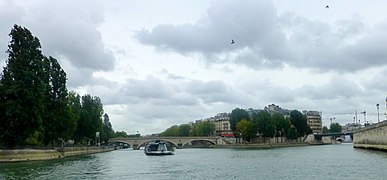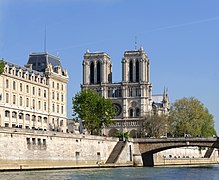Seine river from Paris
| Seine river from Paris | |
|---|---|
|
UNESCO world heritage |
|

|
|
| Downtown Paris, orange area: World Heritage Site |
|
| National territory: |
|
| Type: | Culture |
| Criteria : | i, ii, iv |
| Surface: | 365 hectares |
| Reference No .: | 600 |
| UNESCO region : | Europe and North America |
| History of enrollment | |
| Enrollment: | 1991 (session 15) |
The term Seine banks of Paris describes a UNESCO World Heritage Site that was entered in the World Heritage List in 1991 under the following names: French Paris, rives de la Seine , or English Paris, Banks of the Seine and, of course, simply the river boundaries of the Seine . Unesco is referring to the particularly historic section of the Seine within Paris between the Pont de Sully and the Pont d'Iéna . In addition to the Seine islands Île de la Cité and Île Saint-Louis and the fortified banks of the Seine, the Quais de Paris , adjacent building ensembles, squares, parks and visual axes are also part of the world heritage.
Scope of the world heritage site
The Notre-Dame de Paris Cathedral and the Sainte-Chapelle , both masterpieces of Gothic architecture, are among the outstanding structures on the Seine Islands . On the Île Saint-Louis, there are architectural ensembles connected with the Hôtel de Lauzun and Hôtel Lambert , which as Hôtels particulier exemplarily represent the Parisian architecture of the 17th and 18th centuries. On the northern bank of the Seine, the Rive Droite , the Hôtel de Ville de Paris , the City Hall of Paris, the Gothic church of Saint-Germain-l'Auxerrois are part of the world heritage. Downhill, the Palais du Louvre , the Tuileries gardens to the Place de la Concorde with a connection to the La Madeleine church , the Petit and Grand Palais as well as the Palais de Tokyo and the Palais de Chaillot with the Jardins du Trocadéro follow . On the left bank of the Seine, the Rive Gauche , the Champ de Mars connects from the Eiffel Tower to the Ecole Militaire . Also located south of the Seine, the esplanade to the Hôtel des Invalides with the Invalides Cathedral and the forecourt to the south are part of the World Heritage. The Palais Bourbon , the seat of the Assemblée Nationale , adjoins it. This is followed by the Musée d'Orsay , the École nationale supérieure des beaux-arts de Paris and the Palais de l'Institut, the seat of the Institut de France in the Collège des Quatre-Nations , as well as the Monnaie de Paris , the Mint of Paris, on the Quai de Conti whose continuation, the Quai des Grands Augustins , leads back to the bridges to the Île de la Cité.
The area includes the exhibition grounds of the world exhibitions of 1867 , 1878 , 1889 , 1900 and 1937 and is home to important collections and museums, such as the collections of the Louvre , the Musée de l'Orangerie in the Jardins de Tuileries, the Musée de l'Armée in the Hôtel des Invalides and three museums in the Palais de Chaillot: the Musée de l'Homme , the Musée national de la Marine , and the Musée des Monuments français , and until 2005 also the Musée du Cinéma . 23 of Paris's bridges over the Seine are a World Heritage Site. To the south of the École Militaire, the UNESCO headquarters in Paris borders the World Heritage site.
Appreciation of the cultural significance
The ensemble is to be seen as a geographical and historical unit. Even in prehistoric times, the Seine was formative for the defense and economic development of the villages of the Celtic tribe of the Parisians ( Parisii in Latin ). The city center, which emerged in the 16th and especially in the 17th and 20th centuries, illustrates the relationship between the river and the population. The oldest parts in the east of the World Heritage are characterized by the dense development of the Île Saint-Louis and the Marais district . To the west of the Palais du Louvre, the wide squares and boulevards of Haussmann's urban planning characterize the cityscape. These include the viewing axes at right angles to the Seine: First from the Palais Bourbon via the Place de la Concorde to the parish church of La Madeleine, then the axis from the Hôtel des Invalides via the Esplanade to the Grand and Petit Palais and the axis from the École Militaire via the Field of Mars with Eiffel Tower to the Palais de Chaillot with the Trocadero Gardens. Parallel to the Seine is the axis that starting with Saint-Germain l'Auxerrois through the Louvre to the Place de la Concorde leads, and from there via the territory of the World Heritage Site beyond the de Arc Triomphe to the Grande Arche of La Defense is enough . The Paris model influenced urban planning in the late 19th and early 20th centuries around the world.
As early as when enrolling in 1991, the UNESCO Advisory Board expressed its concern about how strict urban development control could be implemented, not only for the buildings in the areas immediately adjacent to the World Heritage Site, but also for the profile and height of the skyline visible in the background so that the cultural heritage site itself and its line of sight would not be impaired in the future either.
Picture gallery
See also
- Quais, bank reinforcements and roads in P.
- Rive Droite (north bank)
- Rive Gauche (south bank)
- Seine bridges in the Paris area
Web links
- Entry on the UNESCO World Heritage Center website ( English and French ).
- The Banks of the Seine in Paris. (pdf, 160 kB) Advisory Body Evaluation. UNESCO World Heritage Center, May 1991, accessed June 18, 2017 .
- Les rives de la Seine in Paris: délimitation du bien lors de son inscription sur la liste en 1991. (pdf, 6 MB) Entry of the World Heritage area on the city map of Paris. UNESCO World Heritage Center, 2011, accessed June 18, 2017 (French).
- Natascha Albus, et al. : The UNESCO World Heritage . Monuments of humanity - wonders of nature. Kunth Verlag GmbH & Co KG , Munich 2017, ISBN 978-3-95504-413-8 , p. 77 f .
















